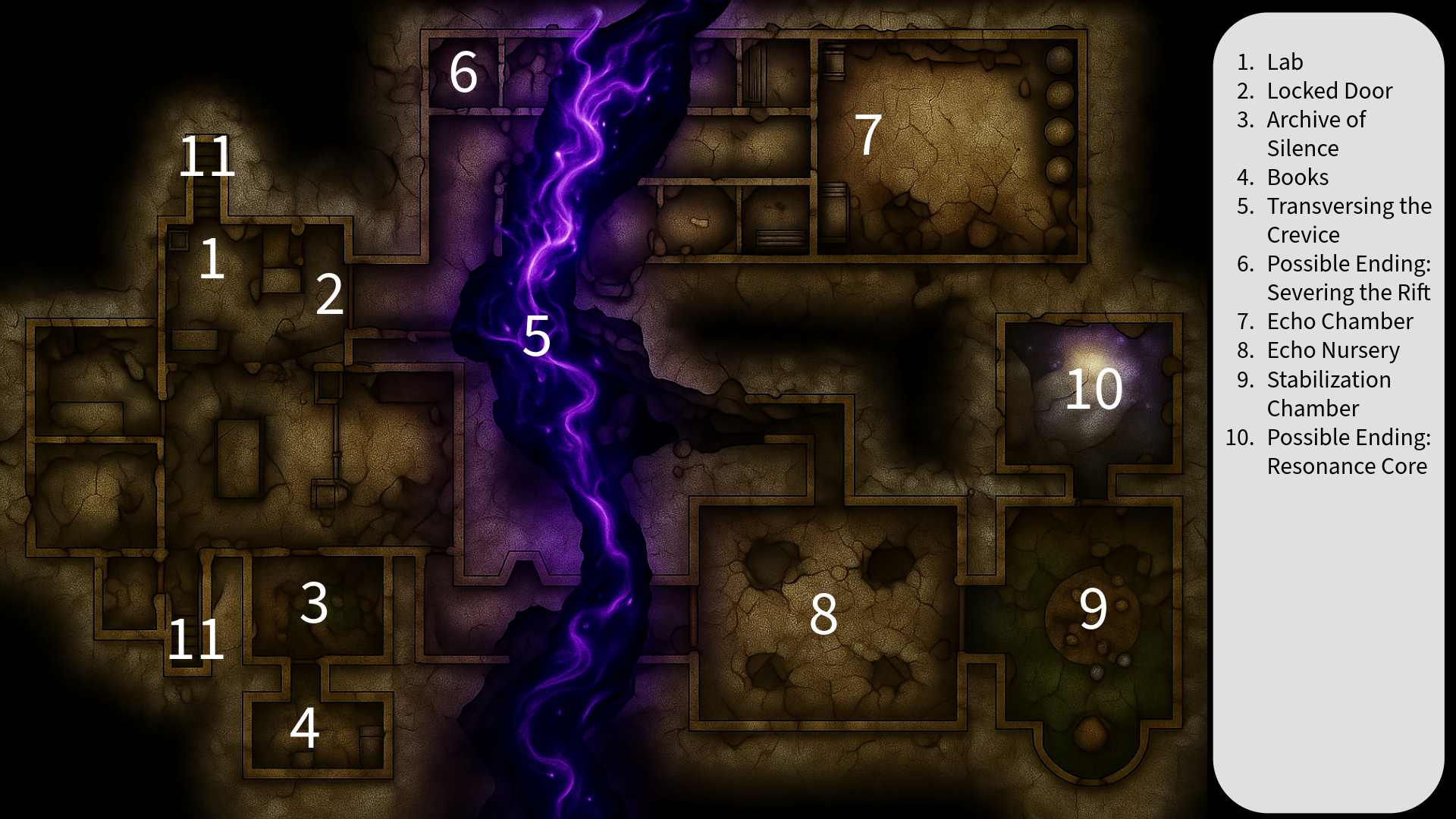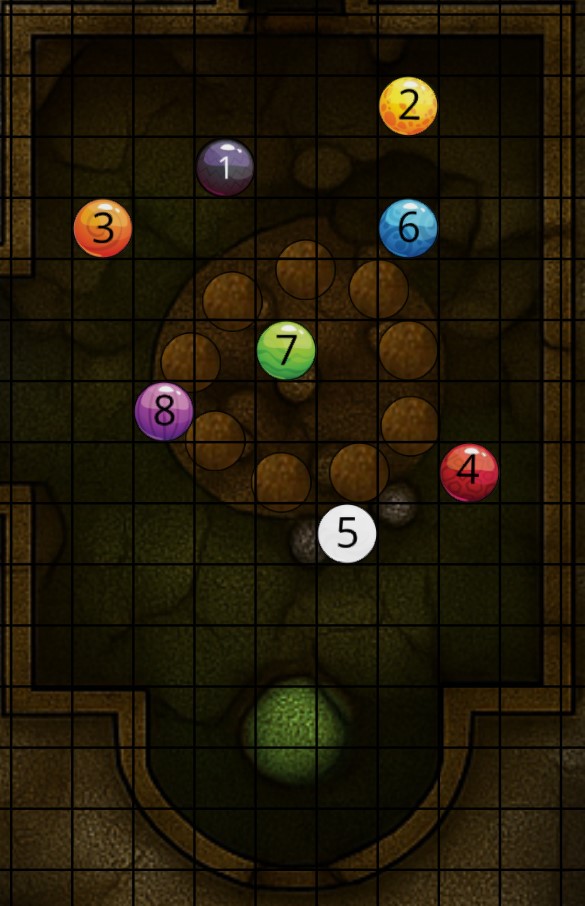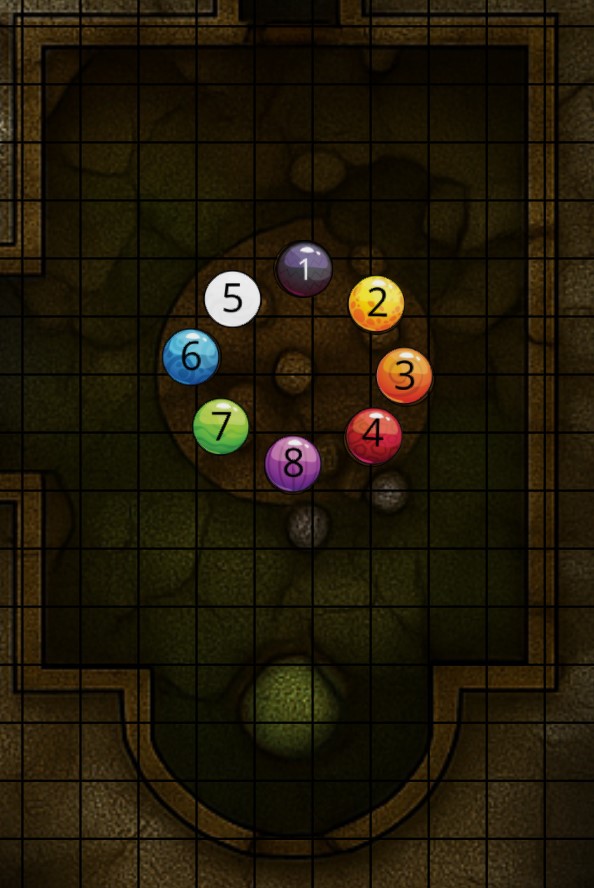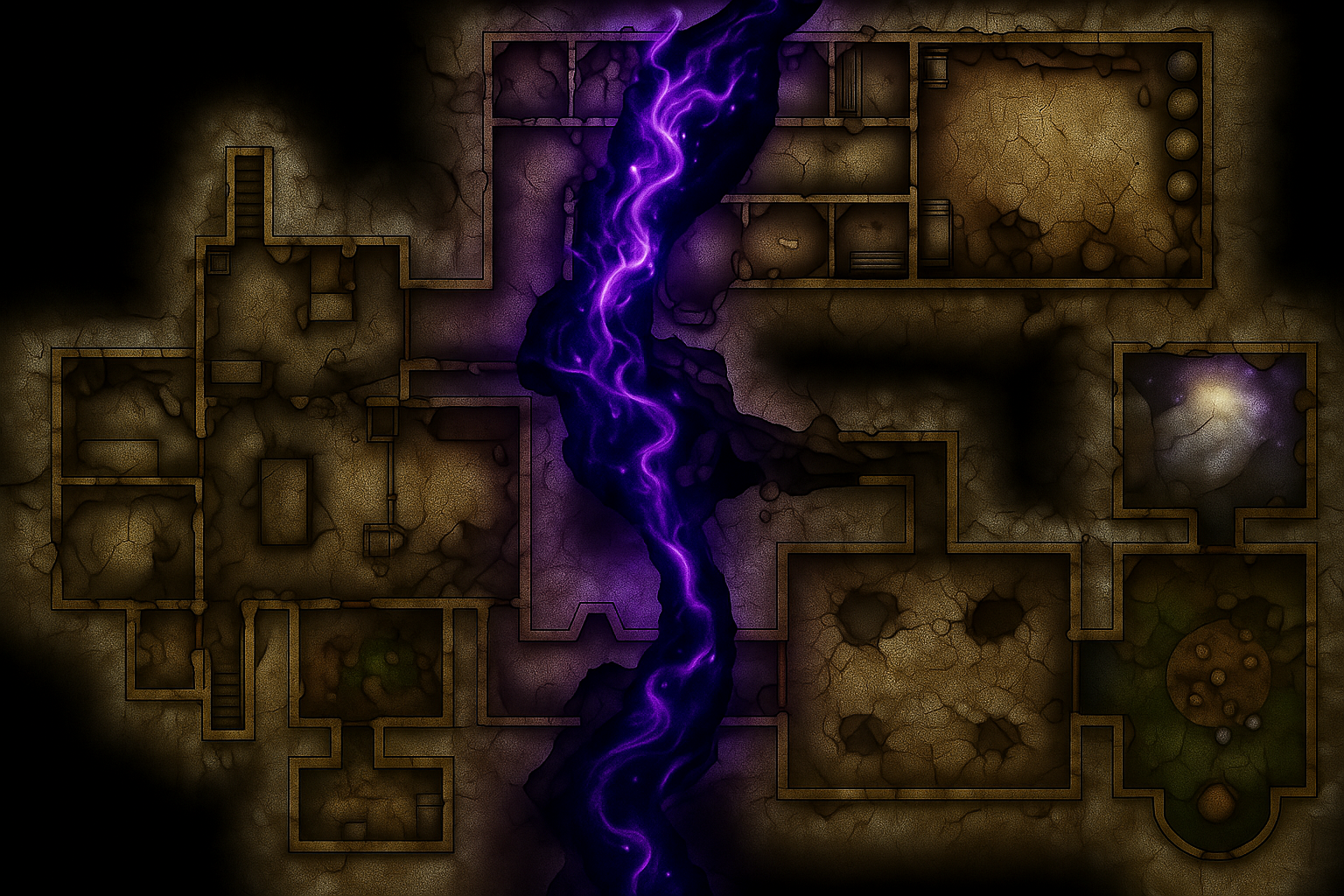Albany Resonance Facility: Third Floor
1. Lab
This ruined lab, once a place of precision and innovation, is now a cracked and crumbling shell of its former self. The walls are stained and fractured, with grime and dark discoloration seeping through the stone like old bruises, and rubble—plaster, wood splinters, and fragments of broken equipment—litters the floor. Faint outlines and scorch marks hint at where tables, machinery, and shelving once stood, while two splintered workbenches lie overturned in the main chamber, their surfaces still bearing embedded clamps and metallic runners.
2. Locked Door
Mechanical Locks
This category includes any mechanical means of forcing a door to remain closed such as a lock or a bar or being welded shut. This also includes things like safes, tool boxes and other kinds of small self securing items. These items require a Lock Picking check with a difficulty determined by the complexity of the lock. If the lock is damaged, rusted or otherwise in poor condition, the complication range increases. These items can also be by passed with a strength check with a difficulty determined by the composition of the item in question.
Picking Locks
Picking a lock is a Slight of Hand check. Having proficiency in Thieves Tools or Engineering as well as having the appropriate tools available for the task allows you to add you proficiency bonus to the roll. Using improved tools (anything other than the Thieves Tools or Engineering kit) results in disadvantage for the roll. You cannot benefit from the help action while picking a lock. Failure to successfully pick the lock has a 10% chance of damaging the lock.
DC 10
Breaking Down a Barrier with Strength
A Strength check can model any attempt to lift, push, pull, or break something, to force your body through a space, or to otherwise apply brute force to a situation. The Athletics skill reflects aptitude in certain kinds of Strength checks.
Athletics: Covers difficult situations you encounter while climbing, jumping, or swimming. Examples include the following activities:
- You attempt to climb a sheer or slippery cliff, avoid hazards while scaling a wall, or cling to a surface while something is trying to knock you off.
- You try to jump an unusually long distance or pull off a stunt midjump.
- You struggle to swim or stay afloat in treacherous currents, storm-tossed waves, or areas of thick seaweed. Or another creature tries to push or pull you underwater or otherwise interfere with your swimming.
The GM might call for a Strength check when you try to accomplish tasks like the following:
- Force open a stuck, locked, or barred door
- Break free of bonds
- Push through a tunnel that is too small
- Hang on to a wagon while being dragged behind it
- Tip over a statue
- Keep a boulder from rolling
Generally, when by passing a mechanical lock or type of obstacle within this category, you will be rolling a strength check rather than an athletics check. If you'd like to have athletics apply, you will need to explain what action you are taking, keeping in mind the above check guidance.
An object’s Armor Class is a measure of how difficult it is to deal damage to the object when striking it (because the object has no chance of dodging out of the way). See the table below for suggested armor classes for objects.
AC 15
HP 20
3. Archive of Silence
Description
The room is unnervingly quiet—no footsteps echo, no breath registers, and even spoken words vanish in the air before reaching another's ears. The air feels heavy with memory, as though thoughts themselves struggle to exist here. Crystals pulse softly in shifting colors, each containing fragmented logs, recorded emotions, or sensory imprints—flickers of lives once lived, now partially erased. Some have been shattered, leaving only voids where memories used to be. The silence here isn’t just the absence of sound—it’s the oppressive weight of things forgotten.
Memory Crystals
In the Archive of Silence, players have the rare opportunity to interact directly with the fractured memory-storing crystals—though doing so comes with both revelations and risks. Each intact crystal can be activated by touch, projecting a fleeting, sensory-encoded memory into the player’s mind: the final thoughts of researchers, conversations about the Rift, or even encrypted emotional data too damaged to interpret clearly. A successful Arcane or Engineering (DC 12) check allows a player to piece together coherent fragments— unlocking knowledge about the facility’s early experiments with the Dark and the use of these crystals.
However, the room’s oppressive metaphysical silence gnaws at identity. If a player spends more than 10 minutes exploring or directly interfacing with more than one crystal, they must succeed on a DC 13 Sanity saving throw or suffer a Indefinite Madness Effect.
A successful Investigation (DC10) check will reveal that there are some empty crystals still present in this room.
4. Books
Searching this room will yield 1d4 books that can be returned to the Scribes.
5. Traversing the Crevice
Crossing the crevice is necessary for the party to successfully cplete their mission and stop the Quieting. There are several ways that they could go about this. Encourage brain storming and problem solving. Allow them to use methods that are close to something in the examples.
Jumping the Gap (Athletics/Acrobatics)
Depending on the exact width of the rift at the attempted crossing point (varies at various sections), characters may attempt a running leap.
Rules: Use standard jump rules. An Athletics check DC 12 required to maintain footing on the unstable edge.
Consequences:
- Failure results in the character falling prone, but safely making the jump.
- Failure by 5 or more results in the player falling partially into the rift, taking 2d6 bludgeoning damage and requiring a Dexterity saving throw (DC 12) to avoid further magical harm (1d6 psychic damage from contact with raw Dark energy).
- It would require climbing to get back to the top of the rift which is an Athletics check DC 12.
Using Rope or Grappling Hook (Dexterity or Intelligence + Tools)
Characters might affix a rope across the rift using pitons, grappling hooks, or magical items. Some of these options would require one character to be on the other side already to secure the route for others, while the grappling hook would allow this option to be used from the starting side.
Rules: Requires a Dexterity (Sleight of Hand) or Intelligence (Tinker’s Tools) check to properly secure the line, DC 13.
- Allow other tools if the characters can make it narratively make sense
Crossing: Once the rope is secure, crossing requires a Dexterity (Acrobatics) check, DC 12.
Consequences:
- Failure results in the character dangling, requiring a Strength check (DC 12) to pull up or assistance from others.
- Failure by 5 or more results in the player falling partially into the rift, taking 2d6 bludgeoning damage and requiring a Dexterity saving throw (DC 12) to avoid further magical harm (1d6 psychic damage from contact with raw Dark energy).
- It would require climbing to get back to the top of the rift which is an Athletics check DC 12.
Building a Makeshift Bridge
Debris, piping, or even lab tables might be used to fashion a narrow walkway.
Rules: Investigation check to find materials, DC 12. Engineering check to construct, DC 12. Allow them to use another check or other tools if they can narratively make it fit.
Crossing: Once the bridge is constructed, walking across requires a Acrobatics check, DC 10.
Consequences:
- Failure results in the character dangling, requiring a Strength check (DC 12) to pull up or assistance from others.
- Failure by 5 or more results in the player falling partially into the rift, taking 2d6 bludgeoning damage and requiring a Dexterity saving throw (DC 12) to avoid further magical harm (1d6 psychic damage from contact with raw Dark energy).
- It would require climbing to get back to the top of the rift which is an Athletics check DC 12.
Using Dark
There are plenty of spells that could help the characters cross.
Root-Jump, Tier 2-Fly, Tier 2-Fabricate, Tier 3-Terraform, Root-Runner (Ritual), Tier 2-Jumper, Tier 3-Gateway (Ritual), Tier 1-Gravity Shifter
Other
There are probably ones solutions that I didn't think of. The idea here is to allow your players to problem solve, so let things work if they are reasonable.
Sanity
At the end of every round that the character is within 10 feet of the rift (edge of the surface before the drop) they will draw a Sanity Effect.
Shadows
There are shadows in the area of the cervice. At the beginning of every round there is a 10% chance that a shadow will attack the party. By pass this step if there is already a shadow attacking them. 1d100 10 or less results in a shadow.
6. Possible Ending: Severing the Rift
Description
This chamber hums with a low, unnatural resonance, the walls themselves subtly vibrating with the pulse of the Dark Rift. At the far end of the room, partially buried under rubble and trailing sparking wires, sits a heavily damaged but still-active terminal. The display flickers with arcane symbols overlaid by a corrupted operating system—half digital code, half pulsing glyphs.
Information
This is the anchor. This system is what's stabilizing the link between the Albany Resonance Facility and the vast, incomprehensible void of the Rift.
When a character interfaces with the terminal, the system resists at first—requiring a successful Intelligence (Arcana or Computer Use) check (DC 16) to parse the shifting interface. If they have the Key Card, the DC is reduced to 12.
With success, a clear message emerges:
"CONNECTION STABLE. ENERGY FLOW: 87%. LOCALITY DISSONANCE AT THRESHOLD.
INITIATE DISCONNECT?
WARNING: PROCESS IRREVERSIBLE. SUBJECTIVE ZONE STABILITY UNKNOWN."
The party is presented with a definitive choice:
Initiate Rift Disconnection?
Consequences of Disconnection
- The Rift Shudders. If the players confirm, a cascade of events begins.
- Description:The rift in the central chamber starts to contract violently. Deep, bassy sounds—like reality cracking—echo through the corridors. All lights flare with magenta hues before extinguishing.
- Change the players to the map that is not glowing.
- Reality Bends. Every character must make a Sanity saving throw (DC 12). On a failure, they suffer 1d6 psychic damage and are stunned for 1 round, overwhelmed by vertigo and a flood of images flashing through their minds.
- The Quiet Ends. If the players survive, the Quiet ceases. Any afflicted areas will slowly return to normal over the following days.
- Trapped: Anyone already lost to the rift is now trapped within it forever.
Alternative: Leave It Active
If the players choose not to shut it down—perhaps fearing the consequences, or lured by the power or mystery of the Rift—they can walk away. The Rift remains open. The Quiet spreads. The facility begins to sink deeper into unstable terrain as the reality fracture grows.
They can also choose another option for closing the rift, this is only one of the possible choices.
Player Agency and Moral Complexity
This moment is not just about success or failure—it’s about choice. Shutting down the Rift saves the world... but may trap someone still inside. Perhaps a lost researcher is tethered to the Rift, or closing it means erasing critical data that could prevent future disasters. Offer a meaningful twist here if you want ambiguity.
7. The Echo Chamber
Description
The air smells faintly of antiseptic and scorched ozone. Four containment pods line the far wall—each large enough to hold a humanoid figure. Two remain mostly intact, their reinforced glass opaque with strange residue. Two are shattered, their interiors collapsed inward as though something imploded from within.
On either side of the sealed entrance door are two sleek, high-tech devices. Their surfaces glow faintly with unreadable glyphs. The device to the left is labeled as a genetic scanner, currently dormant. The device to the right is labeled as a medical analysis pod, its status display blinking a steady amber: “Error: No Subject Detected.” Their exact purposes are not immediately clear.
The Containment Pods
Investigation (DC 13): Reveals that these pods once held live test subjects exposed to the Rift’s energies. One still faintly glows and contains a preserved humanoid silhouette suspended in stasis—unmoving but whole.
- Opening a Pod (Arcana or Engineering DC 15): Risks triggering a burst of temporal distortion.
- On a success, they safely open the pod without any unusual effects, allowing them to examine the body if they choose to do so. There is nothing remarkable about the body other then it is preserved more then they would have expected, looking as if they could wake up any moment.
- On a failure Roll a d6:
- 1–2: The figure disintegrates in a silent flash of violet mist.
- 3–4: Nothing happens, but the pod’s power fades.
- 5–6: A hallucinated version of a PC emerges, staring at them silently before vanishing.
- Stepping into the Pod: If the party manages to open a pod without powering it down, they can step into it and have it close them in. Once closed inside the pod, it will emit a soft hum and flash a read out in front of the eyes of the person inside the pod.
“Rift Stability: 18%. Proximity Fluctuation: Critical. Anomaly Signature: COHERENT ECHO ACTIVE.”
- Grants advantage to Sanity Saves for 1 hour
Echoing Mist
When the players contact the purple mist in this room:
Trigger a Sanity Save (DC 14).
- Fail: The character sees an illusionary version of themselves, making a different life choice (e.g., abandoning the party, something significantly different in their backstory).
- Failure by 5 or more: The illusion becomes temporarily real, engaging the player in conversation. The hallucination asks questions the player never voiced, like:
“If you had taken the other path… who would still be alive?”
“Why do you fear forgetting when forgetting is peace?”
Genetic Scanner
Arcana or Engineering (DC 14): Reveals that this device once cross-referenced genetic material with resonance response. If a player touches it, they see a brief flash of their ancestor or descendant, making a cryptic statement.
Medical Bay
- Medical Use (DC 12 Medicine Check): Can stabilize a dying PC or remove one Sanity Effect.
- Risk: On use, a psychic echo may reactivate—roll a Sanity Save (DC 13) or hear a whisper that loops in your head for the rest of the session:
“You were better broken…”
Environmental Hazard Mechanics
At the start of each round spent in the Observation Theater, roll a 1d4
| D4 | Effect |
|---|---|
| 1 | A random PC hears themselves say something they haven't yet said. Once they've heard it, they feel a strong urge to say it. Wisdom Save (DC 14) to resist. |
| 2 | A double of a random PC appears for 1 turn and mimics their last action. |
| 3 | A random PC experiences time lurch and then begin to repeat itself. They experience the last 5 minutes over again and then time continues as if nothing happened. |
| 4 | All PCs hear a thought that isn’t theirs, delivered in their own voice. |
8. Echo Nursery
Description
The room is empty of furniture or equipment, but filled with drifting, semi-corporeal memory echoes—ghostly fragments of people reliving their final words, traumas, or quiet regrets in silent, looping holograms. Four shallow fractures scar the floor, each filled with slow-churning purple mist that pulses faintly, as if in sync with the echoes themselves. The mist never rises, but gazing into it brings the unsettling sense of being watched—or remembered. Though physically empty, the room feels claustrophobically full, thick with the emotional static of memories not your own—and maybe one that is.
Purpose
Players can interact with echoes to uncover personal memories from NPCs—or even twisted versions of their own. A PC may see an echo of their past self making a choice that didn’t happen in this timeline. They can see fragments of events that happened during the research that was conducted here or even of the Fall itself. This is a place for roleplaying and storytelling, allow the players to describe what their characters are seeing and engaging with if they choose to do so. Nothing here is real so they can dream up anything. It is also a great place to explain world history with glimpses of the Fall if the players are new to the setting.
9. Stabilization Chamber
Description
This is a solemn room bathed in a dim violet glow that seeps from the cracked, rune-inscribed floor beneath your feet. At its center stands a large, heavy table made of dark, polished metal, around which eight spherical metal orbs hover silently in a random, shifting formation. These orbs pulse faintly with ethereal energy, their surfaces etched with delicate glyphs that shimmer as if alive. The walls are lined with faded control panels, many with blinking lights and worn dials, hinting at the chamber’s former purpose. A subtle hum vibrates in the air as a small terminal to the right powers up and its screen flickers to life.
Investigating the Table Reveals
- The table contains 8 recessed slots arranged in a circle.
- There are 8 metal balls, each a different color and Each ball is engraved with a number.
Red 4, Orange 3, Yellow 2, Green 6, Blue 7, Violet 5, Black 1, White 8
Terminal Displays the Following Clues:
“Opposition stabilizes. Eight forces—four harmonies.
Balance begins in shadow and ends in the light.
United pairs aligned to the nine realms."
Puzzle Rules:
Each opposite pair must sum to 9:
- Slot 1 opposite Slot 5
- Slot 2 opposite Slot 6
- Slot 3 opposite Slot 7
- Slot 4 opposite Slot 8
Solution
| Slot | Color of ball | Number on Ball |
|---|---|---|
| 1 | Black | 1 |
| 2 | Yellow | 2 |
| 3 | Orange | 3 |
| 4 | Red | 4 |
| 5 | Violet | 8 |
| 6 | Green | 7 |
| 7 | Blue | 6 |
| 8 | White | 5 |
Reward for Solving the Puzzle:
When the players correctly place all 8 balls, the table hums with resonance. The metal slots seal shut, the runes in the floor flash once with radiant violet light, and the control ring pulses.
All players may remove one active Sanity effect OR Regain 1d8 Hit Points (player’s choice).
10. Possible Ending: The Resonance Core
Description
At the heart of the Albany Resonance Facility lies the Resonance Core—a chamber unlike any other in the complex. The architecture warps here: walls bend subtly toward the center, light bends strangely, and every sound feels muffled, like being underwater. The air thrums with pressure and presence, and the room pulses in sync with the distant heartbeat of the Rift. Floating in the center of the chamber is a half-formed, spectral entity—shimmering like heat haze, eyes of hollow starlight, limbs coalescing and dissolving in slow rhythm.
DM Note
This is the Fey Echo, a being not of this world but drawn to the Rift’s resonance, feeding on memory like nectar.
Entering the Room
When the players enter, the Fey’s voice enters their minds—not with words, but sensations: longing, hunger, confusion. Then, finally, meaning:
"I am not yet born. I am shaped by remembrance. Feed me... and I shall make it whole."
The Players’ Choices:
1. Give the Memory Shards
If the party has discovered the two Memory Shards hidden throughout the facility—fragments of emotion, thought, and identity—they may offer these to the Fey. Upon doing so, the shards drift from their hands and dissolve into the being, which grows more solid, more real. Its form stabilizes into something beautiful and terrible— shifting like a dream. With a gentle gesture, it exhales. The Rift closes behind it like a curtain falling shut. No noise. No explosion. Just… silence.
*Change to the map without the light
The creature then thanks the players with a sensation of warmth and familiarity—and vanishes. They may leave in peace.
2. Give Personal Memories
If the party does not have the shards—or chooses a more personal sacrifice—the Fey allows them to offer their own memories. Each character may choose to give up one meaningful personal memory, costing them a Contact (a loved one, mentor, or meaningful NPC) being erased from their past. This is represented mechanically by removing a relationship from their backstory. However, that NPC does not forget the relationship. 2 Personal Memories must be given. They can be given by the same character or two different characters.
The Fey accepts these gifts solemnly. It forms fully, radiant with memories given, and collapses into the Rift. As it consumes the echoing strands of forgotten lives, the Rift vanishes. The facility falls quiet. The Quiet ends.
*Change to the map without the light
Note: The party can choose to offer more then 2 memories and it will accept all that is offered. If 4 or more memories are given to the Fey it will bond to the party and become the Side Kick to the party member that gave the most personal and pleasant memory.
3. Fight the Fey
If the party rejects the idea of feeding this being—or sees its presence as too great a threat—they may choose to fight it. This battle is brutal and surreal. The Fey lashes out with tendrils of light and shadow, distorting reality and invading the players' minds. They must make Sanity saves throughout the encounter to avoid temporary madness or memory loss.
If they succeed in defeating the Fey, the result is not clean. The creature dies with a scream that rips through the planes, and the Rift violently collapses. Alarms blare. Tremors shake the facility. Walls crack. The entire building begins to collapse in on itself as the unstable energies once tethered by the Fey surge out of control.
The players have 1 minute (10 rounds) to escape the facility before they are buried in rubble and caught in a surge of planar backlash. Dexterity saves, Athletics checks, and creative use of spells or items may be required to survive. This ending is thrilling, harrowing—and final.
Reflections
This ending forces the players to weigh personal loss, moral consequence, and sacrifice. Feeding the Fey may feel alien and disturbing, but it leads to the gentlest resolution. Fighting offers agency and defiance—but risks destruction. Whatever they choose, it brings a conclusion to the Quieting. Whether through sacrifice, compassion, or fire, the silence will end.
Let them leave changed.
Final Note:
Encourage each player to briefly narrate their reaction to the Rift's shutdown or to walking away from the decision. Let this moment be a tone-setting conclusion to the story of The Quieting: was it triumph, or simply survival? Whether the Church considers this mission a success or not isn't as important to the manner in which this will shape the characters as the move forward in their story. Are they risk takers or are they survivors? Will they complete a mission at any cost or must they save everyone? Draw out what it is that the characters value as the foundation for their choices.







Comments
Author's Notes
The map was created using Dall-E. I used the Cloning Laboratory provided by Tom Cartos for free use and modified it to make it look like a ruin.